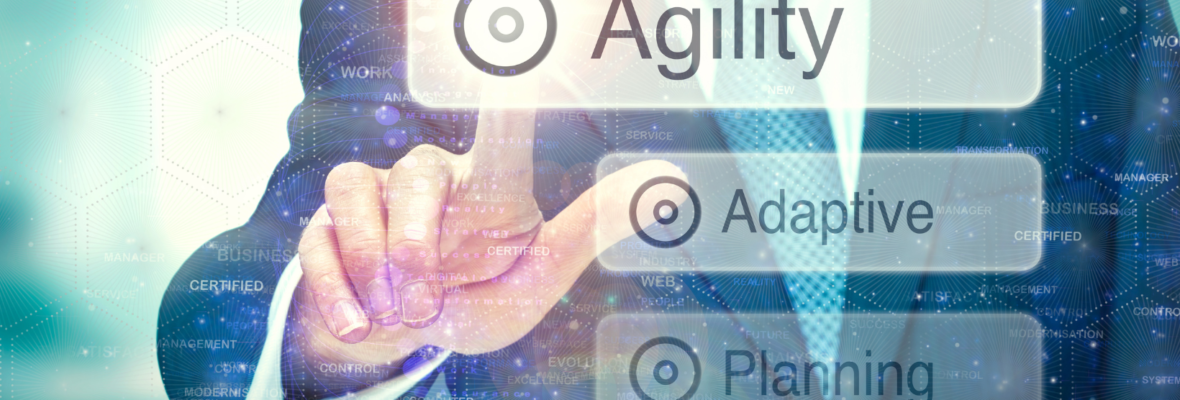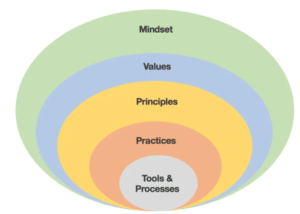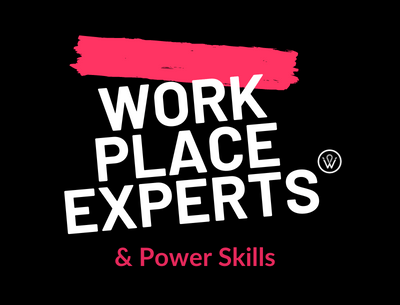
What is Agile?
Big or small, many organizations claim they are agile. But has agile become a buzzword? Is it just a fashionable thing of a moment that will soon be forgotten and what does it have to do with Learning & Development?
In this article Katrina and Ola from WeWent will be exploring these and more questions together and will share practical tips to get you started with the agile mindset.
 So let’s start with clarifying what agile means.
So let’s start with clarifying what agile means.
The Agile Alliance points that “Agile is the ability to create and respond to change. It is a way of dealing with, and ultimately succeeding in, an uncertain and turbulent environment.”
In today’s VUCA World Businesses must constantly adapt to change. The context we are living in today has accelerated the rate of change. Business as usual no longer exists. So you would probably agree with us – that the ability to respond to change is a key performance inidicator and success factor for any organization.
And the L&D function is no different here! Developing business agility is as important for our domain too. Most L&D teams share the need to improve their ways of working, to update their systems, and deliver value to their end customer – the learner, quickly!
Agile is a set of values and principles, rather than specific processes, which describes a mindset for how people and organizations can work effectively together.
You may wonder what are the benefits of being an agile organization? An agile L&D organization is able to leverage the mindset to be more effective and productive while providing significantly higher value to its organization. Without a doubt, the benefits of implementing an agile business model are obvious. However, there are also significant challenges associated with such a shift and these can sometimes be less clear. Take a moment to consider these four general strategies that can help you get started when transitioning your organization towards agile!
1. Develop the Right Mindset
 Agile is a new way of thinking, not simply a process or a tool. This means your team must make Agile principles the foundation of its culture.
Agile is a new way of thinking, not simply a process or a tool. This means your team must make Agile principles the foundation of its culture.
A popular way to explain this concept is that you should “be agile” not “do agile.”
When developing an Agile mindset, remember to:
Embrace failure
Ensure your team understands that failure leads to knowledge and success. This is best achieved by working with prototypes, experiments and test. Fail fast – and learn fast.
Consider these questions for your L&D Team:
Which of your L&D ideas could you test with a simple prototype? Can you consider launching a test on a smaller target group before going with a new training program or offering to the entire organization? How will you know your test was successful or failed?
Welcome feedback.
Build the muscle of constantly asking for feedback from your customers and stakeholders. Encourage honest and open feedback between all members of your team. Use reviews to reflect on the what and retrospectives to focus on the how.
Consider these questions & ideas for your L&D Team: Who are the 5-10 people that you will ask for feedback from on your new L&D product or service idea? In your next team meeting share one learning and one improvement on the ways of working in your team.
Understand your customers.
Every person within your function should know your key customers and you need to obsess about delighting them
Consider these questions & ideas for your L&D Team:
Who are the 3 key personas that use your L&D product, process or service? What are their key needs and pain points? When was the last time you spoke directly with your customer? And who is the end customer for your organization? Do you know how your work impacts the end customer?
Add value incrementally. Slice down big projects and ideas into
An agile culture relies on trust, teamwork, and innovation. This means engaging your employees in the changes you will need to make.
It’s easy to understand why the basics of an agile workplace – clear goals, increased autonomy and improved communication –are naturally aligned with better employee engagement. In a world where unpredictability has become the norm, transitioning towards an agile business approach can benefit all businesses. A gradual adaptation of agile techniques can help your business increase its adaptability and reduce reliance on slower-moving traditional business methods.
To conclude on agile mindset we like to refer to Simon Power’s Agile Onion.

2. Teams over individuals
The agile way of working involves assembling flexible networks of project-oriented teams made up of different specialists who are assembled and disassembled as required. It’s no longer about one “superstar” employee but about bringing together high-performing teams that benefit from their diverse knowledge, experience, and perspectives. An agile team and culture rely on honesty, accountability, responsiveness, and continuous feedback. Dealing with conflict is essential to working together well.
As suggested in the HBR Article “Agile teams ultimately rely on psychological safety — an environment of rewarded vulnerability — to have a collaborative dialogic process.”
To succeed, agile teams need to: keep on asking questions and admit their mistakes, explore new ideas, and challenge the status quo. That’s what psychological safety is all about. It depicts people’s emotional security in teams. A team that values psychological safety operates more effectively, increases morale, and cultivates growth within the organization
Wanting to know more benefits of having psychological safety within the workplace?
3. Transparency over secrecy
To become a more agile L&D Team, you must get to grips with unambiguous and accessible communication methods. The times when L&D Team would lock themselves out and create their products, processes, and even systems in isolation are over too. So making sure what you do, and engaging your end users, and stakeholders in the work you do are key to success. Today, quality communication is essential for any organization to succeed. Many agile teams use information dashboards and virtual boards to provide real-time communication channels that allow teams to collaborate and understand what’s going on. Trello and Slack are intuitive and work well in an agile workplace.

So how can you show transparency of your L&D work within the workplace and have clear communication? How can you help your L&D Team visualize work and limit work in progress?
The answer can be a simple Kanban Board? Having a simple structure of “Backlog”, “To Do” “In Progress” and “Done”. This is also a great tool to help your team visualize and appreciate the team’s collective work over individual progress.
4. Improve the organization’s culture and structure
Organizational culture represents the attitudes, behaviors, and beliefs of your employees. Organizational structure is how people come together to get work done. So how to improve those?
First, you need to understand how important it is for an innovative L&D organization to understand what agile means. And here we recommend starting with an agile mindset first. Second, leaders and L&D experts need to learn the ability of the design thinking approach. A people-centered approach aims to align business goals, strategies, solutions, and initiatives with real-world problems, challenges, and opportunities.
For your L&D organization to become agile it requires change, flexibility, transparency, and communication.
And you need to be ready to experiment a lot as there is no recipe with agile. You need to know your context first – what could work in your organization and team? What practices are already in place that align with agile mindset and behaviors? What new approaches would your team be willing to try next? Which L&D program, project, or process could be done with an agile approach? Is there an innovation you are looking to implement or a complex new idea you are grappling with? And who could join the agile team to work on solving the challenge together?
So how do you help your organization transform and meet the challenges of a volatile, uncertain, and complex world?
How can your L&D organization transform? Start small, experiment, and be agile!
In this article, we’ve provided you with an overview of what that is, and how it can be done. Much of it is about changing the way you think about learning and development. By adopting a problem-solving attitude and focusing on delivering quick wins you can transform your L&D into a lean, flexible and responsive organization. A lot of businesses still struggle with this concept. So to deliver on both the growing expectations of organizations and learners, we believe that L&D strategy must now reflect the increasing expectation for agility in learning. The 4 strategies explained above will help your L&D organization to get started with agile. Do you need further support in transforming your L&D business and team to become more agile? Contact us and our team of experts at WeWent will help you achieve your goals!





